Flowers similar to hyacinths are few, and they are as gorgeous as the flowers themselves, however, the similar ones do have different properties. While the beautiful blue flowers of a hyacinth may be hard to replicate, there are still a few varieties of perennials that exude the same elegance and vibrancy, which provides a similar feel to it.
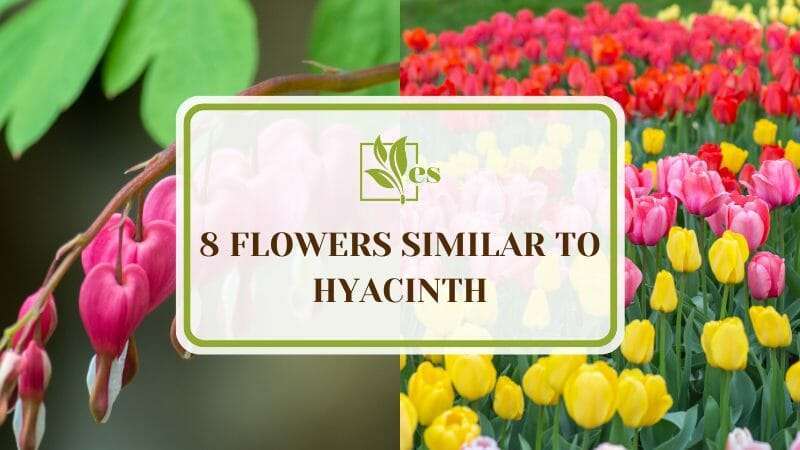
If you wish to learn more about them, keep reading.
JUMP TO TOPIC
A List of Flowers That Look Similar to Hyacinth
1. Bluebells
Hyacinths, bluebells, or Hyacinthoides, are spring bulbs that thrive in zones 4 to 9. Before going dormant in the summer, Hyacinths and Bluebells bear clusters of flowers atop long stems for five weeks. In addition to the latter, these vibrant flowers are well-known for their fragrant sweetness.
Although they do look like hyacinth, with their features of bunched blooms, however unlike hyacinths, they require shadier settings and are frequently planted behind deciduous trees. In addition, bluebells require constant irrigation to keep the topsoil moist.
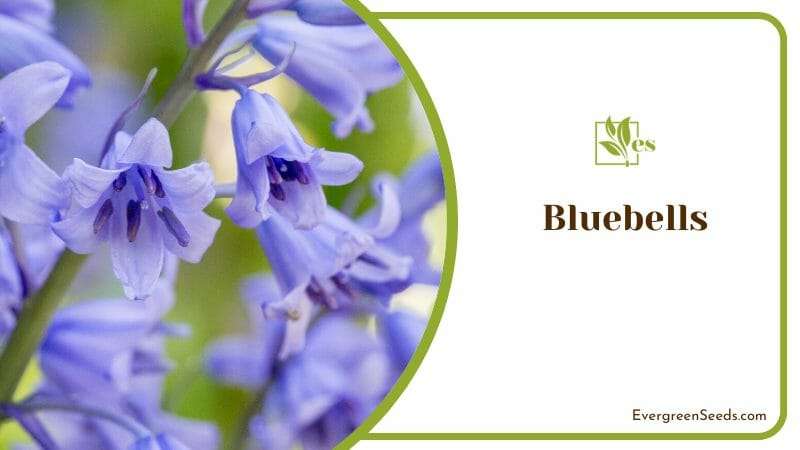
These purple flowers must be planted in aerated soil because excessive moisture might lead to bulb rot. Nonetheless, high-potassium fertilizer will encourage wholesome blooms after buds develop.
– Characteristics
They have a pointy tip, are smooth and hairless, and have a strap-like form. Bluebells are bell-shaped flowers with six petals that are typically a deep violet-blue color and have upturned tips.
In addition to that, they also have creamy white pollen inside these flowers with sweet scent nods or droops to one side of the flowering stem or inflorescence. As this scent is the one that would attract pollinators in the months of early spring season.
– Care
To grow hyacinth, they need to be provided with full sun; however, they would also prefer moderate shade in the summer but require lots of light in the early spring when they are blooming. Bluebells would also require moist, well-drained, somewhat fertile soil, not full-on organic.
Overall, they can adapt to any sort of soil. English bluebells need plenty of moisture during the spring or when the climate begins to warm up and spring growing seasons. After planting, give bulbs plenty of water. Rinse the area to keep the soil moist when the top two to four inches feel dry.
2. Muscari
The name “grape hyacinth” is also often known as “Muscari armeniacum” as it refers to a small spring-blooming bulb with tightly packed flower clusters that resemble grapes.
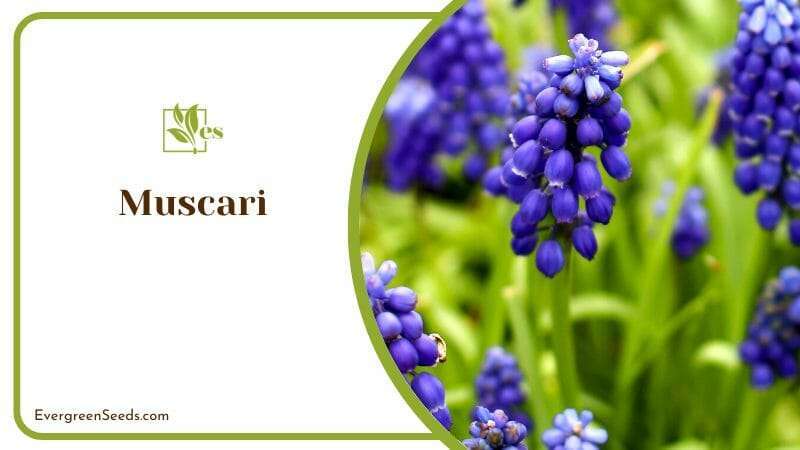
Grape hyacinths are workhorses that may brighten the early spring flower garden for years with little to no care. Not only that, but also these grape hyacinths are one of the hyacinth varieties that grow slowly and are best planted in the fall. They emerge and bloom the following April or May, lasting for about three weeks.
– Name Specifications
It is now thought that the Muscari genus belongs to the Asparagaceae, or asparagus family, rather than the Liliaceae family, which also includes real hyacinths. As they are native to Europe and Asia, hence they would show a similarity as they grow in different regions, hence the family they are from would be looked upon.
Look at other family members to discover any outward similarities: All three asparagus, lily-of-the-valley, and brodiaea lily species have flowering umbels that develop from a central stem.
– Characteristics
Many different grape hyacinth cultivars exhibit the unusual crystal blue color that many gardeners desire, yet they lack the fussiness of certain other blue flowers. Additional hues are also available; the white, pink, and yellow grape hyacinth cultivars offer a welcome contrast when grown alongside the blue kinds. These would start to blossom up during spring and attract different pollinators.
– Care
While it may tolerate little shade, grape hyacinth thrives in direct sunlight. Remember that many another shaded locations in the summer are sunny in the spring before the neighboring trees have leafed out.
Which means that you must plant it in any area of your property with well-drained soil for the best results. While grape hyacinths prefer some moisture in the spring, as the season goes on, their soil should be let to dry out gradually.
3. Lilies
Perennial bulbs in the genus Lilium have several similarities to hyacinths in preferred growing environments. Both genera can be grown effectively in growth zones four to nine and like sunny locations with moist, well-drained soil.
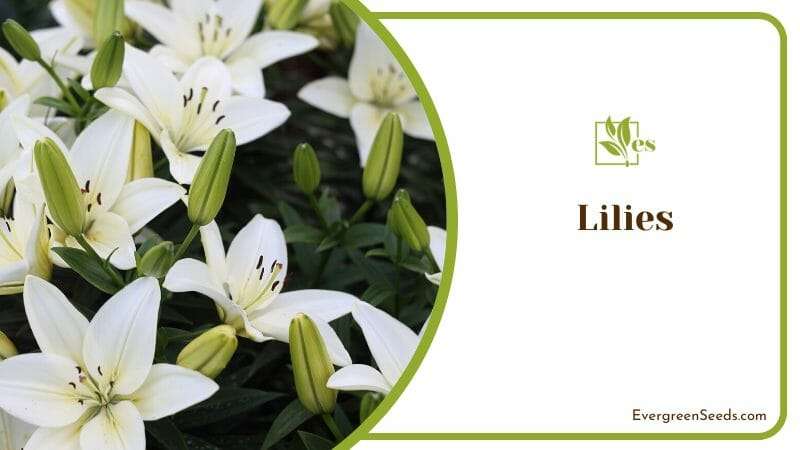
Unlike hyacinth bulbs, which only bloom in the spring, lilies can bloom anywhere from early summer to late summer, depending on the kind.
To help hold heavier bulbs and shield branches from powerful winds, stake taller lilies. An excess of moisture and poor airflow brings on gray mold.
– Characteristics
Lilies typically have six-petaled flowers in a range of shapes (trumpet, funnel, cup, bell, bowl, or flat), occasionally nodding and with reflexed petals, atop stiff, unbranched stems that are one to eight feet tall and covered in linear to elliptic leaves. Flowers occur in a wide variety of colors—all but blue—and are frequently fragrant.
– Care
Care guide for lilies suggests they must be kept moist while growing and do their best with liberal watering hand in hand with proper soil care.
Furthermore, similar to Grecian windflower, the lilies would require consistent hydration when actively growing, especially in drier locations. First, the topsoil should be covered with a layer of mulch for Lilies since excessive moisture might cause root rot. Next, add a thin layer of compost and potassium-rich fertilizer to the soil to promote wholesome blossoms in the spring.
As you liberally irrigate it, water conservation by mulching will help to keep the soil cool and moist. Lilies should ideally have at least two fertilization sessions throughout their growth cycle.
4. Terrestrial Orchids
Hyacinth and other members of the Orchidaceae family have elongated stems covered in clusters of colorful blooms. In addition, several orchid varieties go through a dormant period in the colder months.
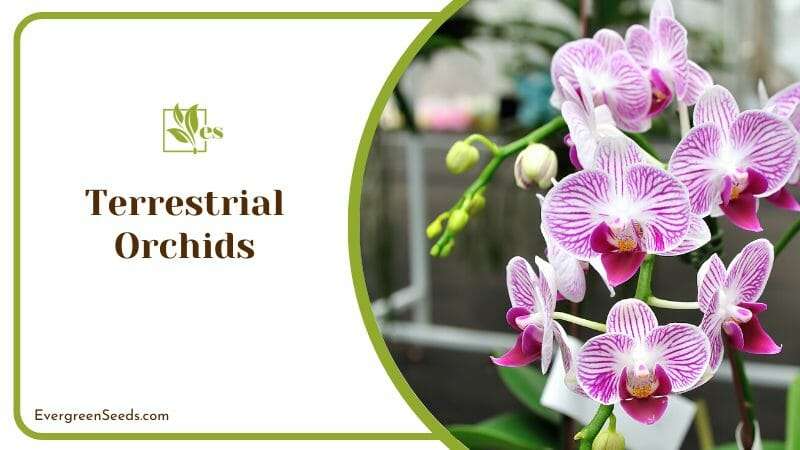
Since orchids must preserve energy to establish their root systems, develop leaves, and as a result they would blossom up to every eight to twelve months during this phase, fertilization must be reduced.
– Characteristics
Three sepals, three petals, and an ovary with three chambers make up an orchid flower. Two of the petals and the three sepals are frequently similar, but one petal usually has significant modifications that produce a “lip” or labellum.
Although certain orchid cultivars are pest-resistant, they are vulnerable to root rot. In addition, their habitat must be well-ventilated to help evaporate stagnant water-carrying bacteria and lessen the harsh sun that burns leaves.
– Care
Similar to hyacinth care, orchids that will blossom need strong light. However, they can get burned in the sun. Orchids are common houseplants that thrive when their specialized needs for light, air, water, food, and rest are provided.
They grow naturally in the ground in environments tailored to each kind; in addition, they should receive strong, indirect light because of their thriving blossoms and healthy green foliage.
Hence what you must do is to choose direct, bright lighting from a south or east-facing window, for example so that it wouldn’t be a harsh light coming to it. In normal potting soil or potting mix, orchids cannot grow.
Alternatively, you might buy or construct your light, quickly draining orchid growing media. In order to prevent rot, orchids need to dry out between waterings. If the growing material seems dry to the touch and the pot feels light, it may be time to water.
5. Freesia
Freesia is a perennial bulb, much like hyacinth flowers bulbs, that thrives in sunny locations with fertile soil that drains well. Freesia, on the other hand, is unable to endure colder regions since Hyacinth can only thrive in growth zones 9 to 10.
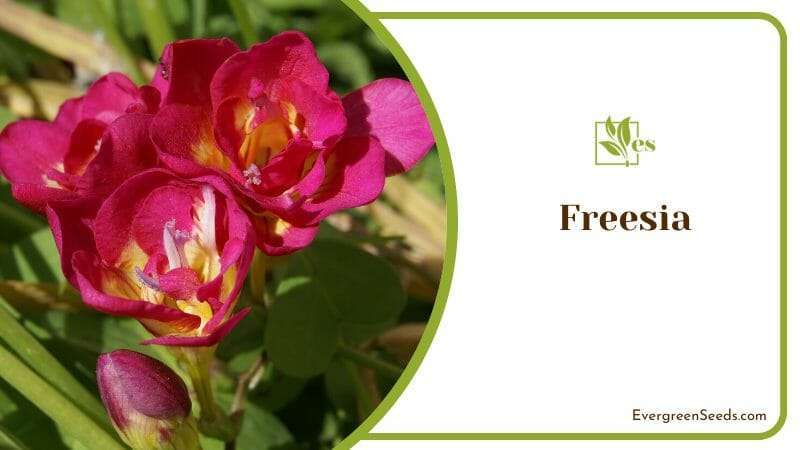
These indigenous African bulbs favor a minimal watering schedule. To prevent root rot when sprouts are forming, the soil must be moist yet well-aerated. Freesias require weekly watering while in bloom, but they prefer drier soil and less water outside those times.
– Characteristics
Fall is the ideal season to plant freesia bulbs because they start to grow actively. First, pick a sunny garden area with rich yet light soil. The optimum soil is sandy garden loam that has been humus- or compost-added. Since the bulbs are small, planting them deeper than two inches is unnecessary.
Instead, put them with the pointed end facing up. Furthermore, groups of at least five to seven plants make the plants appear their best. After setting the bulbs about three inches apart, thoroughly water the planting area. The freesias should begin to flower about 12 weeks after the bulbs are planted.
It’s common to include freesia flowers in bouquets, just like the hyacinth, they would also blossom and feature vivid colors and an alluring scent; however, these bulbs grow most actively in the fall, so it is preferable to plant them then. Nevertheless, freesias typically bloom 12 weeks after planting, and you can enjoy their magnificent blossoms throughout the spring and summer.
– Care
Full sun is ideal for freesia growth, they can, however, endure planting in an area that receives some early shadow. A south-facing window that receives plenty of sunlight is great for growing them indoors.
For freesia plants, well-draining soil is essential. To increase drainage, you can amend the soil with organic material like compost or peat moss. While the new sprouts are forming, keep the soil moist but not saturated. When your plants are in bloom, water them once a week. If the foliage turns yellow and starts to wilt, decrease watering and let the soil dry out.
6. Bearded Iris
The long branches of the Iris germanica are renowned for their eye-catching spring blooms. Since these perennial bulbs, like hyacinths, go dormant in the early to mid-summer, it is preferable to sow them in the early fall.
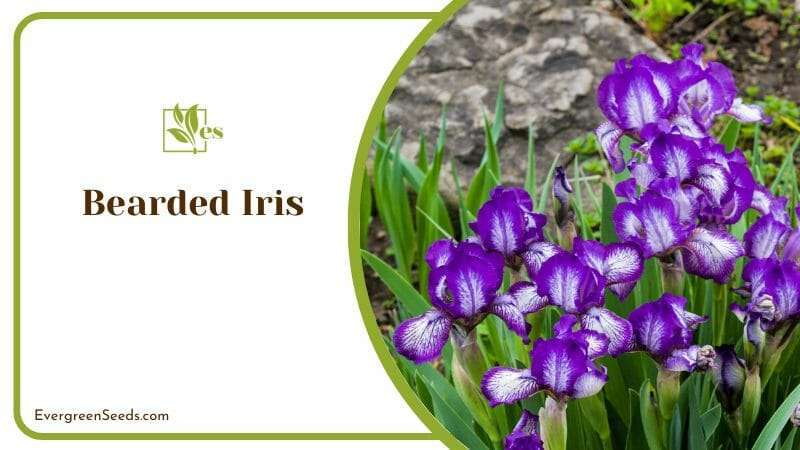
Irises and hyacinths flourish in zones three to nine, where they are more likely to receive direct sunlight.
– Characteristics
Bearded irises, the most common variety, are the easiest to cultivate if you put them in a sunny location with well-drained soil. Irises are grown differently from other perennials because they do not fare well with mulch.
Plants should be placed at least 12 inches apart to avoid having to divide them frequently. Like pink pearl, Iris don’t have many issues, but periodic lifting and dividing are required to control iris borer worms and maintain healthy, productive plants.
Irises are renowned for being hardy plants that can thrive in various soil types. Irises should be planted in raised beds with compost added to the soil to improve drainage if you want to prevent root rot. In addition, you can promote robust blooms by incorporating bone meal and a low-nitrogen fertilizer into the soil.
– Care
Iris growth requires direct sunlight. Irises grown in complete shade have fewer blooms and are more likely to contract illnesses.
Sand or gravelly soils are ideal for growing iris; heavy clay soils are unsuitable. They can be grown in raised beds to aid drainage if your soil is heavy. Leave the soil uncovered because mulches, as well as deep planting, promote the rhizomes to develop rot.
Irises enjoy wetness but require proper drainage to avoid rot issues, when the first two inches of the soil feel dry, water them. These plants can withstand drought well.
7. Tulips
Hyacinth and Tulipa species have several characteristics. Hence they are frequently cultivated together. Both plants are perennial bulbs that bloom in spring with colorful blooms. Gardeners grow Tulip cultivars with various bloom times to enjoy their blooms from early to late spring.

Tulips are cold-hardy plants that can benefit from snow cover during the winter since they inhibit development and protect foliage. Tulips prefer warmer hardiness zones with full afternoon sun, but they are also cold-hardy plants that can benefit from snow cover.
Like daffodils, tulips are recognizable spring flowering bulbs that add color to gardens well before most other flowering plants have established themselves. They are among the earliest cultivated plants, and hybridization has allowed them to produce almost all colors except pure blue. Two to six broad, strappy leaves with a waxy coating and a blue-green hue are seen on the plants. The majority of tulips only have one flower per stalk. However, some do.
– Characteristics
In most places, tulip bulbs are typically planted in the fall, when they will get the winter chill they need to bloom in the spring. Tulips develop and bloom swiftly after emerging from the ground. They normally emerge in March and bloom from April to May in cold-winter areas.
Tulips are perennial bulbs. However, wide hybrid varieties are fairly transient. Maintaining a large display of tulips necessitates planting more bulbs each autumn for the spectacle the following spring.
– Care
After planting the bulbs, give them a good quick soak in water. After that, save additional watering for prolonged dry periods. Rich, draining soil with a neutral pH to slightly acidic is what tulips prefer (six to seven). Compost can help with drainage and give the bulbs nourishment.
Tulips of all types prefer direct sunlight. However, keep in mind that in the early spring, when tulips are actively growing, regions under deciduous trees that are gloomy in the summer are generally sunlit.
8. Bleeding Heart
The herbaceous perennial Lamprocapnos spectabilis, appropriately known as “bleeding heart,” has exquisite heart-shaped blooms hanging from its stems. These plants bloom in the spring and remain for a few weeks, just like hyacinths.
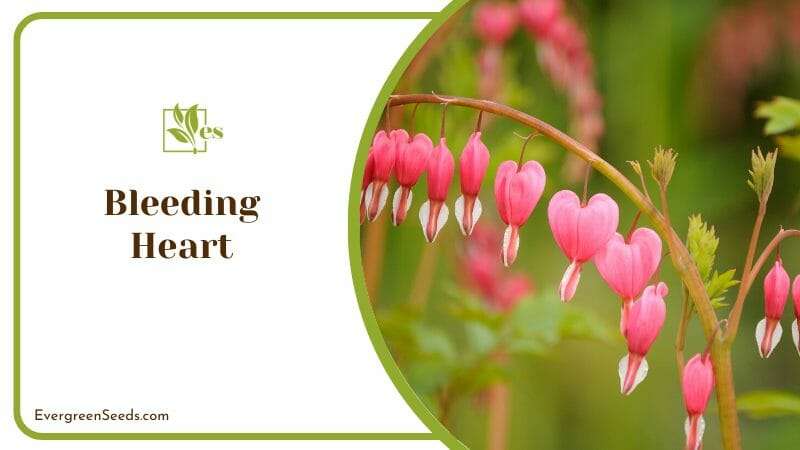
These plants bloom in the spring and remain for a few weeks, just like hyacinths. However, when temperatures rise in the middle of the summer, bleeding heart foliage goes into dormancy.
– Characteristics
The size of a bleeding heart ranges from about one to three feet high, with a comparable spread. The plant grows slowly, achieving its maximum size in around 60 days. Because a bleeding heart harms people and animals, be careful where you plant it.
– Care
Although it can tolerate full shade, the bleeding heart performs best in partial shade. Hardiness zone 9 is tolerable for these plants, but they prefer cooler climates where they can be planted in complete shade.
Direct sunlight may shorten the plant’s blooming season by causing it to go dormant earlier. Although bleeding hearts do not require fertilizer, putting a layer of leaf mold into the soil promotes robust blooms.
Furthermore, the humus-rich, wet, well-draining soil with abundant organic matter is what the bleeding heart favors. It prefers soil that is just slightly damp. It can’t stand dry or wet soils very well.












